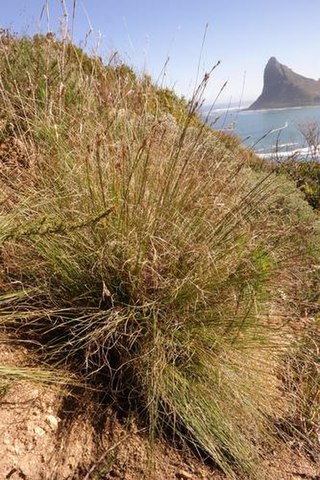
The Cyperaceae are a family of graminoid (grass-like), monocotyledonous flowering plants known as sedges. The family is large; botanists have described some 5,500 known species in about 90 genera – the largest being the "true sedges", with over 2,000 species.

Lepidosperma is a genus of flowering plant of the family Cyperaceae. Most of the species are endemic to Australia, with others native to southern China, southeast Asia, New Guinea, New Caledonia and New Zealand.

Schoenus is a predominately austral genus of sedges, commonly known as bogrushes, or veldrushes in South Africa. Species of this genus occur mainly in South Africa, Australia and Southeast Asia. Others are found in scattered locations worldwide, from Europe to Asia, North Africa and the Americas. Three species occur in the peatlands of southern South America, including S. antarcticus which is found in Tierra del Fuego, where it forms a component of hyperhumid Magellanic moorland.

Actinoschoenus is a genus of the sedge family. According to a 2021 taxonomic revision based on molecular data, it is considered to consist of two species, namely Actinoschoenus aphyllus (Vahl) Larridon and Actinoschoenus repens J.Raynal. Reference databases Plants of the World Online and the World Flora Online Plantlist also consider Actinoschoenus yunnanensis (C.B.Clarke) Y.C.Tang to be part of the genus. Previously, Actinoschoenus was circumscribed more widely, and also included five species native to Australia:
Jeremy James Bruhl is an Australian botanist. He is an emeritus professor in the School of Environmental and Rural Science at the University of New England and director of the N.C.W. Beadle Herbarium which holds c.110,000 plant specimens.

Tetraria is a genus of flowering plants in the sedge family, Cyperaceae, native to Tanzania, South Africa, Borneo, Australia and New Zealand.
Karen Louise Wilson is an Australian botanist.

Schoenus quartziticus is a species of sedge endemic to the Agulhas Plain region of the Western Cape Province in southern South Africa.

Schoenus compar is a species of sedge endemic to southern South Africa.

Schoenus graminifolius is a species of sedge endemic to the Cape Peninsula of South Africa.

Schoenus ligulatus is a species of sedge endemic to the western regions of the Western Cape Province of South Africa.

Schoenus bracteosus is a species of sedge endemic to the mountains of southern South Africa.
Russell Lindsay Barrett is an Australian botanist.

Morelotia is a genus of flowering plants belonging to the family Cyperaceae. It contains six species of sedges native to New Zealand, the Hawaiian Islands, Tubuai Islands, and Western Australia.

Schoenus complanatus is a species of sedge endemic to the western mountains of the Western Cape Province of South Africa.

Schoenus brunnescens is a species of sedge endemic to the Western Cape Province of South Africa.

Anthelepis clarksonii is a plant in the Cyperaceae family, first described in 2019 by Russell Barrett, Karen Wilson and Jeremy Bruhl. It is found in Queensland.
Anthelepis guillauminii is a plant in the Cyperaceae family, first described in 1938 by Georg Kükenthal as Schoenus guillauminii, with the current name being given in 2019 as belonging to the new genus, Anthelepis by Russell Barrett, Karen Wilson and Jeremy Bruhl. The species is native to New Caledonia.

Anthelepis paludosa is a plant in the Cyperaceae family, first described in 1810 by Robert Brown as Chaetospora paludosa, with the current name being given in 2019 with a reassignment to the new genus, Anthelepis, by Russell Barrett, Karen Wilson and Jeremy Bruhl. The species is native to New South Wales and Queensland.

Anthelepis undulata is a plant in the Cyperaceae family, first described in 1804 by George Henry Kendrick Thwaites as Cladium undulatum with the current name being given in 2019 with a reassignment to the new genus, Anthelepis, by Russell Barrett, Karen Wilson and Jeremy Bruhl.
















